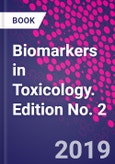Biomarkers in Toxicology, Second Edition, is a timely and comprehensive reference dedicated to all aspects of biomarkers that relate to chemical exposure and their effects on biological systems. This revised and completely updated edition includes both vertebrate and non-vertebrate species models for toxicological testing and the development of biomarkers. Divided into several key sections, this reference volume contains new chapters devoted to topics in microplastics, neuroimmunotoxicity and nutraceuticals, along with a look at the latest cutting-edge technologies used to detect biomarkers. Each chapter contains several references to current literature and important resources for further reading.
Given this comprehensive treatment, this book is an essential reference for anyone interested in biomarkers across the scientific and biomedical fields.
Table of Contents
Part I. Toxicity Testing Models and Biomarkers 1. Introduction 2. Rodent Models for Toxicity Testing and Biomarkers 3. The Göttingen Minipig as large animal model in toxicology 4. Nonhuman primates in preclinical research 5. Biomarkers of toxicity in zebrafish 6. Mechanistic Toxicology Biomarkers in Caenorhabditis elegans 7. Drosophila melanogaster, Eisenia fetida, and Daphnia magna for toxicity testing and Biomarkers 8. Alternative animal toxicity testing and biomarkers 9. Adverse outcome pathways and biomarkers
Part II. Systems Toxicity Biomarkers 10. Central nervous system toxicity biomarkers 11. Peripheral nervous system toxicity biomarkers 12. Cardiovascular toxicity biomarkers 13. Respiratory toxicity biomarkers 14. Hepatic toxicity biomarkers 15. Conventional and emerging renal biomarkers 16. Gastrointestinal toxicity biomarkers 17. Reproductive toxicity biomarkers 18. Biomarkers of toxicity in human placenta 19. Early Biomarkers of Acute and Chronic Pancreatitis 20. Skeletal muscle toxicity biomarkers 21. Ocular biomarkers in diseases and toxicities 22. Biomarkers of Ototoxicity 23. Blood and bone marrow toxicity biomarkers 24. Immunotoxicity biomarkers
Part III. Chemical Agents, Solvents and Gases Toxicity Biomarkers 25. Bisphenol A (BPA) Biomarkers and Biomonitoring 26. Insecticides 27. Herbicides and fungicides 28. Polychlorinated biphenyls, polybrominated biphenyls, and brominated flame retardants 29. Polycyclic aromatic hydrocarbons 30. Metals 31. Melamine 32. Biomarkers of petroleum products toxicity 33. Biomarkers of chemical mixture toxicity 34. Biomarkers of toxic solvents and gases
Part IV. Biotoxins Biomarkers 35. Freshwater cyanotoxins 36. Mycotoxins 37. Poisonous plants: biomarkers for diagnosis
Part V. Pharmaceuticals and Nutraceuticals Biomarkers 38. Biomarkers of drug toxicity and safety evaluation 39. Risk Assessment, Regulation and the Role of Biomarkers for the Evaluation of Dietary Ingredients present in Dietary Supplements 40. Nutriphenomics in rodent models: Impact of dietary choices on toxicological biomarkers
Part VI. Nanomaterials and Radiation 41. Engineered nanomaterials: Biomarkers of exposure and effect 42. Biomarkers of Exposure and Responses to Ionizing Radiation
Part VII. Carcinogens Biomonitoring and Cancer Biomarkers 43. Biomonitoring exposures to carcinogens 44. Genotoxicity biomarkers: Molecular basis of genetic variability and susceptibility 45. Epigenetic biomarkers in toxicology 46. Breast cancer biomarkers 47. Pancreatic and ovarian cancer biomarkers 48. Prostate cancer biomarkers
Part VIII. Disease Biomarkers 49. Biomarkers of Alzheimer's disease 50. Biomarkers of Parkinson's disease 51. Biomarkers for drugs of abuse and neuropsychiatric disorders: Models and mechanisms 52. Osteoarthritis biomarkers 53. Pathological biomarkers in toxicology 54. Oral pathology biomarkers
Part IX. Special Topics 55. Biomarkers of mitochondrial dysfunction and toxicity 56. Biomarkers of blood-brain barrier dysfunction 57. Biomarkers of oxidative/nitrosative stress and neurotoxicity 58. Cytoskeletal disruption as a biomarker of developmental neurotoxicity 59. Membrane transporters and transporter substrates as biomarkers for drug pharmacokinetics, pharmacodynamics, and toxicity/adverse events 60. Citrulline: Pharmacological perspectives and role as a biomarker in diseases and toxicities
Part X. Applications of Biomarkers in Toxicology 61. Analysis of toxin- and toxicant-induced biomarker signatures using microarrays 62. Biomarkers detection for toxicity testing using metabolomics 63. Transcriptomic biomarkers in safety and risk assessment of chemicals 64. Percellome toxicogenomics project as a source of biomarkers of chemical toxicity 65. Proteomics in biomarkers of chemical toxicity 66. Biomarkers for Testing Toxicity and Monitoring Exposure to Xenobiotics 67. Biomarkers in epidemiology, risk assessment and regulatory toxicology








